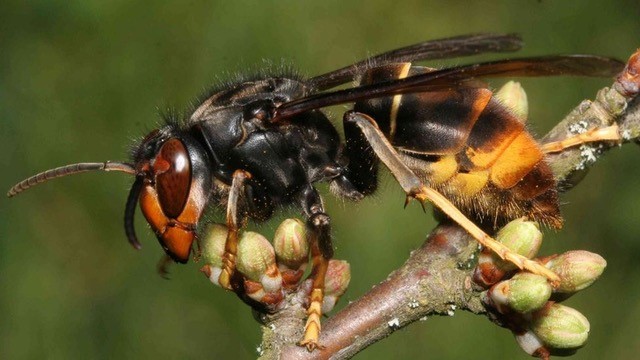Bee Blog February 2019
I am Gerald Bushby (pronounced bush bee!) a beekeeper in Weston on the Green, a small village in Oxfordshire. I am going to be writing a monthly blog about the bees in my apiary. I hope you will find it interesting. I should start by saying that I am not an expert, having only kept bees for three years. Anything I say is my own personal opinion; I accept that there may often be other views and opinions.
As this is a quiet time of year in the apiary I thought I could focus on an issue I have not covered before; pests and diseases. I will start by concentrating on a relatively new threat to honey bees in this country posed by the Asian hornet Vespa velutina. Why is it a problem to honey bees? It hovers around bee hives, catches bees and eats them.
As the name suggests this hornet originates from Southeast Asia, particularly the tropical regions, from Northern India, Pakistan, Afghanistan, Bhutan, China, Taiwan, Burma, Thailand, Laos, Vietnam, Malaysia, the Indo-Chinese peninsula and surrounding archipelagos. Like so many other pests and diseases it appears to have taken advantage of mankind’s transport and travel to become an invasive species throughout Europe. It is believed to have arrived in France in boxes of pottery from China in 2004. In 2010 it was in Spain and in 2011 Portugal. The first sighting in the UK was in Tetbury in 2016.
In their native regions the Eastern honey bee has evolved a strategy of avoiding hovering hornets by rapid entry and exit from the hive when hornets are about. The guard bees also ball hornets to death. Unfortunately the British honey bees have not yet had sufficient time to develop a defensive strategy to overcome the concentrated hawking by hornets. British bees, Apis mellifera, approach their hives more indirectly and slowly, instead of darting in as fast as possible in the way that far Eastern cousins do. They are easy pickings for the Asian Hornet.
Asian hornets hunt a very wide range of insects, including flies and dragonflies, capturing them by pursuit. The major concern about their invasiveness however, is that when they find a bee colony or an apiary, they tend to settle down and specialise in honeybees as their prey. A hornet occupies a position above a beehive as its hunting territory. It flies about within an area of about half a square metre, scanning the direction from which foraging bees return to the hive. Each hornet vigorously defends its hunting territory, chasing off any rivals. However, as soon as it catches a bee it flies off and another hornet replaces it, usually within a few seconds.
Like other hornets, Asian hornets build nests that may house colonies of several thousand individuals. Females in the colony are armed with formidable stingers with which they defend their nests and kill their prey. The nest is of paper, similar to a wasps nest, roughly in the shape of a huge egg, usually at least half a metre in length. The nesting season is long, and a colony commonly begins by building a nest in a low shrub, then abandoning it after some months and rapidly build a new one high in a tree, possibly as an anti-parasitic measure. The next generation of young queens disperses in the late autumn to hibernate over winter.
Why should we be worried? In 14 years the Asian Hornet has become endemic in France, it has decimated the local bee populations and it has been held to be responsible for the deaths of several people from anaphylactic shock and heart attacks. These hornets are very aggressive and will attack people if they approach within a few meters of their nests.
Asian hornets are mostly black with only the last segment of their bodies being yellowy/orange. They have yellowish legs are slightly smaller than European hornets. Their sting is no more powerful than a European hornet's but they are considered to be more aggressive in that they can attack even if they are not themselves being threatened. One Asian hornet can also sting several times. The British Beekeeping Association produce a very good factsheet on their web site, with illustrations, explaining how to identify these hornets.
So far it is thought that all Asian hornets nests found in the United Kingdome have been eradicated but it is not easy to find the hornets or their nests. To date there have been 13 confirmed sightings of the Asian hornet in England and 6 nests have been destroyed. Nine sightings occurred in 2018 in Lancashire, Hull, three in Cornwall, two in Hampshire, one in Surry and the latest in Kent.
Any immigration deal associated with Brexit is unlikely to affect the Asian hornet !
I am a proud supporter of the ‘Bees for development’ charity, my love of the bee drew me to this wonderful UK based charity and the great work they do around the world with Bees and the impact they can have on people’s lives. Please help me support this wonderful organisation, as 2BScientific will be doing with donations to this hard-working charity.
